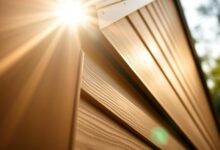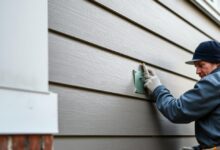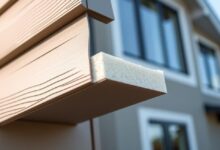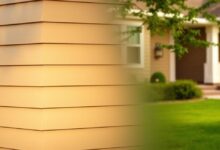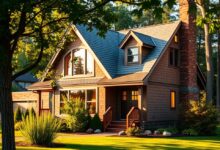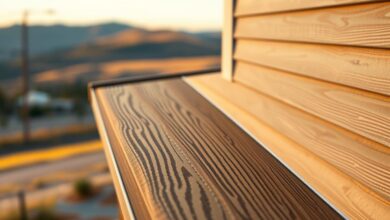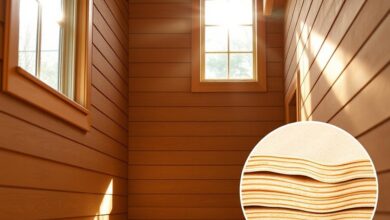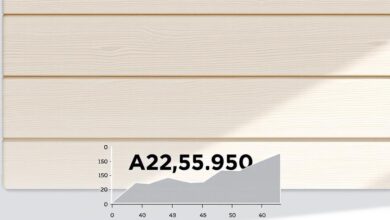Wood Insulated Siding: Enhance Your Home’s Exterior
Looking to make your home’s exterior look better and save on energy? Wood insulated siding is a great option. It boosts your home’s look and cuts down on energy bills.
This exterior siding combines wood’s natural beauty with home insulation. It gives your home a strong and good-looking finish.
Key Takeaways
- Enhance your home’s exterior with a durable and attractive finish.
- Improve energy efficiency with home insulation benefits.
- Increase your property’s curb appeal with natural wood.
- Reduce energy costs with this innovative siding solution.
- Enjoy a long-lasting exterior siding solution.
What Is Wood Insulated Siding and How Does It Work?
Wood insulated siding combines wood with insulating materials. It creates a strong and energy-saving exterior finish. This siding is a green and beautiful choice for homes.
The Structure and Components
Wood insulated siding has wood fibers or strands mixed with foam. This mix gives it great heat control and keeps the wood look. The main parts are:
- Wood fibers or strands
- Insulating materials (e.g., foam)
- Binding agents for cohesion
How It Differs from Traditional Siding
Wood insulated siding is different from regular siding. It has insulation built right into it. This makes it easier to install and saves energy.
The Science Behind Its Insulation Properties
The insulation in wood insulated siding comes from its mix. The foam inside stops heat from moving, keeping homes cozy. This saves energy and cuts down on carbon emissions.
Wood insulated siding is a smart choice. It makes homes look good and saves energy.
Benefits of Wood Insulated Siding for Your Home
Wood insulated siding offers many benefits, including energy efficiency and cost savings. It’s also good for the environment. Homeowners are choosing it to make their homes better and save energy.
Energy Efficiency and Utility Cost Savings
Wood insulated siding helps cut down on energy use. It adds insulation, which means less heat loss in winter and less heat gain in summer. This can save a lot on utility bills over time.
Temperature Regulation Year-Round
Wood insulated siding keeps your home at a steady temperature all year. It keeps homes warm in winter and cool in summer. This makes your home more comfortable and livable.
Noise Reduction Capabilities
Wood insulated siding also makes your home quieter. The extra insulation blocks out more noise, making your home peaceful and calm.
Environmental and Sustainability Advantages
Wood insulated siding is good for your home and the planet. It’s made from natural, renewable materials. Plus, many products are recyclable or reusable, which helps the environment.
Choosing wood insulated siding brings many benefits. You’ll save on energy and money, and help the environment. As people look for green and energy-saving homes, wood insulated siding will stay a top choice.
Popular Types of Wood Insulated Siding Options
Wood insulated siding comes in many types, like cedar, pine, and engineered wood. This variety lets homeowners pick the best siding for their needs and style. It’s all about finding the right fit for your budget and taste.
Cedar Insulated Panels
Cedar insulated panels are loved for their natural beauty and strength. They’re made from Western Red Cedar, which fights off rot, decay, and bugs. Cedar insulated panels also keep your home warm and can fit many styles.
Pine and Spruce Varieties
Pine and spruce wood siding is cheaper than cedar but just as good. These softwoods are treated to last longer and work well in classic and rustic homes. They’re easy to finish in many ways to match your style.
Engineered Wood Insulated Products
Engineered wood is made by layering wood fibers. This makes it less likely to shrink or expand with temperature. It’s a budget-friendly choice that looks like natural wood and insulates well.
Composite Wood Insulation Systems
Composite wood insulation mixes wood with other materials for better performance. This includes:
Fiber Cement Combinations
Fiber cement combines wood fibers with cement for a strong and fire-safe siding. It’s easy to care for and looks like wood.
Wood-Polymer Composites
Wood-polymer composites blend wood fibers with plastic. They look like wood but last longer and resist rot and bugs. Plus, they’re made from recycled materials, making them eco-friendly.
| Type of Siding | Durability | Cost | Insulation Properties |
|---|---|---|---|
| Cedar Insulated Panels | High | Moderate to High | Excellent |
| Pine and Spruce Varieties | Moderate | Low to Moderate | Good |
| Engineered Wood Insulated Products | High | Moderate | Good |
| Composite Wood Insulation Systems | High | Moderate to High | Excellent |
Installation Process for Wood Insulated Siding
To enjoy the perks of wood insulated siding, knowing how to install it is key. The process has several important steps that need careful planning and doing.
Professional vs. DIY Installation Considerations
Many homeowners wonder if they should hire a pro or do it themselves. DIY might save money, but professional installation is best for tricky siding jobs. This is because pros bring the needed precision and know-how.
Preparation and Materials Required
Before you start, make sure you have all the right stuff. You’ll need the siding panels, flashing, fasteners, and weatherproofing stuff. Having everything ready can avoid delays and problems.
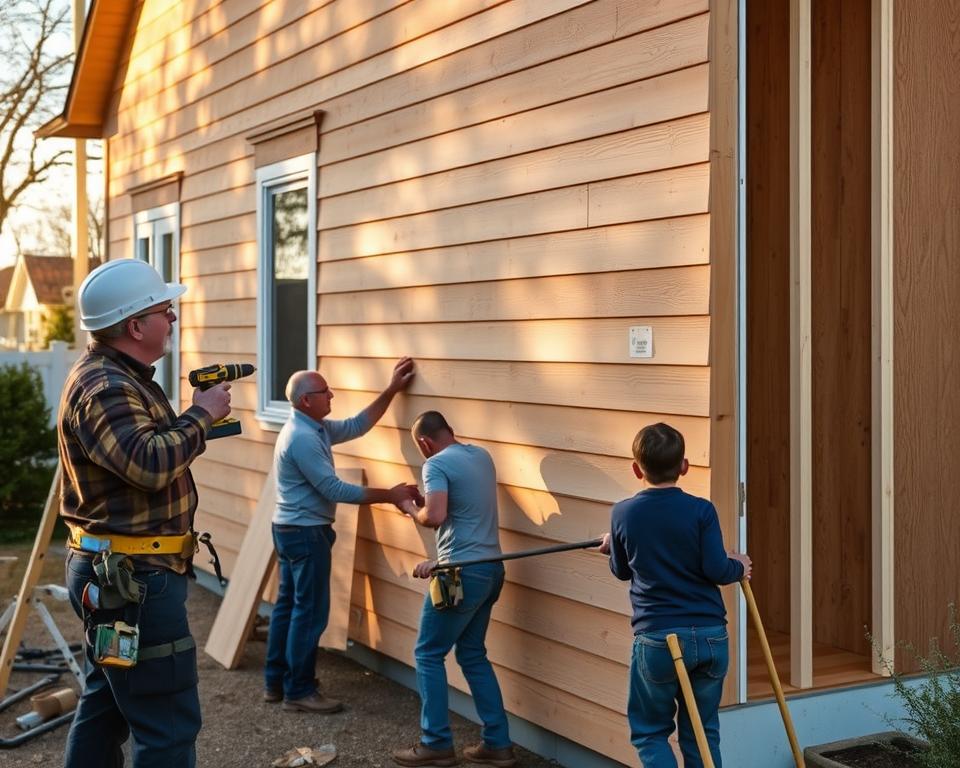
Step-by-Step Installation Overview
The first step is to take off the old siding. Then, check and fix any damaged sheathing. After that, put on a weather-resistant barrier. Install the siding panels from the bottom up, making sure they’re aligned right and fastened securely.
Common Challenges and Solutions
Installing siding can be tough, like dealing with uneven surfaces and sealing around windows and doors. To fix these, use adjustable fasteners and caulk or weatherstripping. This keeps air leaks and water out.
Cost Factors and Return on Investment
Investing in wood insulated siding can be a smart move. But what are the main cost factors and returns on investment homeowners need to know?
The initial cost of wood insulated siding varies a lot. This depends on the type of wood. For example, cedar insulated panels are pricier than pine or spruce.
Average Material Costs by Wood Type
Material costs are a big deal. Prices range from $3 to $10 per square foot. This depends on the wood type and quality.
Installation and Labor Expenses
Installation costs add another $2 to $5 per square foot. This depends on the job’s complexity and local labor rates.
Long-Term Energy Savings Calculation
Homeowners can save 15% to 20% on energy bills each year. This is thanks to the better insulation from wood insulated siding.
Property Value Enhancement
Wood insulated siding also boosts property value. It makes homes more appealing to buyers if the owner decides to sell.
By looking at both cost factors and return on investment, homeowners can decide if wood insulated siding is right for them.
Enhancing Your Home’s Exterior with Wood Insulated Siding
Wood insulated siding is a great choice for homeowners wanting to improve their home’s look and save on energy. It helps lower utility bills, keeps temperatures steady, and makes homes more eco-friendly.
There are many types of wood insulated siding, like cedar panels and engineered wood. Knowing how to install it and what it costs is key for a good outcome.
Choosing wood insulated siding can make your home look better and save you money over time. It also increases your home’s value. So, it’s a smart and green option for upgrading your home’s exterior.
